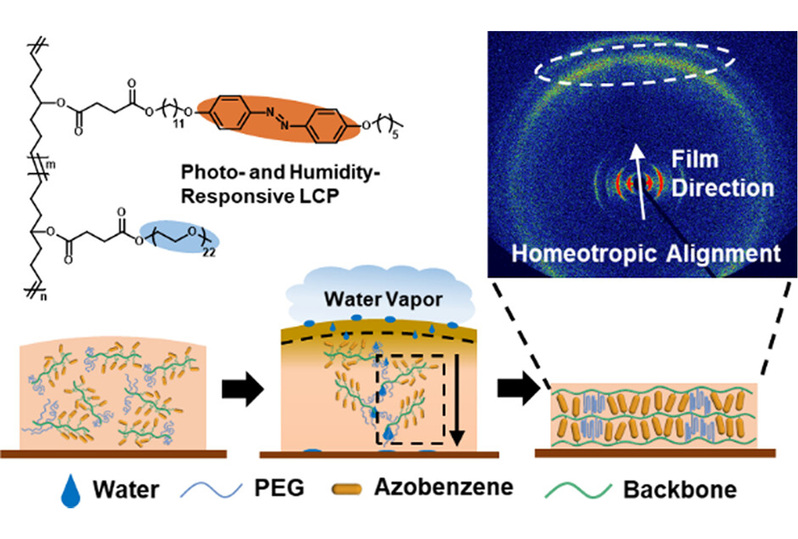Search
Title: Photo- and Humidity-Responsive Liquid Crystal Copolymer Actuators Fabricated via Vapor-Assisted Alignment
Author: Haozhe Sun, Xingpeng Chai, Haipeng Yang, Jia Wei*, Yanlei Yu*
Journal: ACS Appl. Mater. Interfaces 2024, 16, 15405−15415
Abstract:
Deformable liquid crystal polymers (LCPs) driven by more than one external stimulus have received extensive attention in fields ranging from multifunctional soft robots to bionic actuators. Combining responsive liquid crystal with nonmesogenic responsive groups within polymer offers a versatile way to obtain multiresponsive LCPs. However, the incorporation of nonmesogenic responsive groups causes interruption in the assembly of mesogens and brings a challenge to the alignment of LCPs. Herein, a new method is put forward to facilitate uniform mesogen alignment by exerting water vapor in the film preparation process. Using this method, vapor-assisted alignment, the homeotropic alignment of azobenzene mesogens is achieved in a copolymer containing nonmesogenic poly(ethylene glycol) (PEG). The obtained copolymer films present photodeformation brought by azobenzene isomerization and humidity-responsive deformation resulting from the asymmetric swelling of film surfaces. The dual-responsive smart “blinds” and bionic flower actuators are fabricated to demonstrate the integration of the two different stimuli. This work is anticipated to provide a feasible alignment method for multiresponsive LCPs, showing the potential applications in soft robots, sensors, and biomimetic devices.
Fulltext Link: https://pubs.acs.org/doi/10.1021/acsami.4c01809

Deformable liquid crystal polymers driven by multiple stimuli have potential applications in the fields of multi-functional soft robots and bionic actuators. The combination of stimulus-responsive liquid crystal units and non-liquid crystal units provides more opportunities for obtaining multi-stimulus-responsive liquid crystal polymers. However, the introduction of non-liquid crystal elements will disturb the arrangement of liquid crystal elements, making it difficult for liquid crystal polymers to form an ordered structure. In this work, we use a new orientation method to realize the ordered arrangement of the liquid crystal elements in the copolymer system, that is, to apply steam in the film forming process of the copolymer of azobenzene and polyethylene glycol. The results show that the vapor-assisted orientation strategy promotes the vertical orientation of the liquid crystal elements in the thin films, and successfully achieves the ordered assembly of the polycycloctene liquid crystal polymers containing non-liquid crystal groups. On this basis, we construct dual response actuators such as intelligent curtain, bionic flower and bionic vine. We hope that this vapor induced orientation strategy can provide a new design idea for the preparation of multi-response liquid crystal copolymers.







